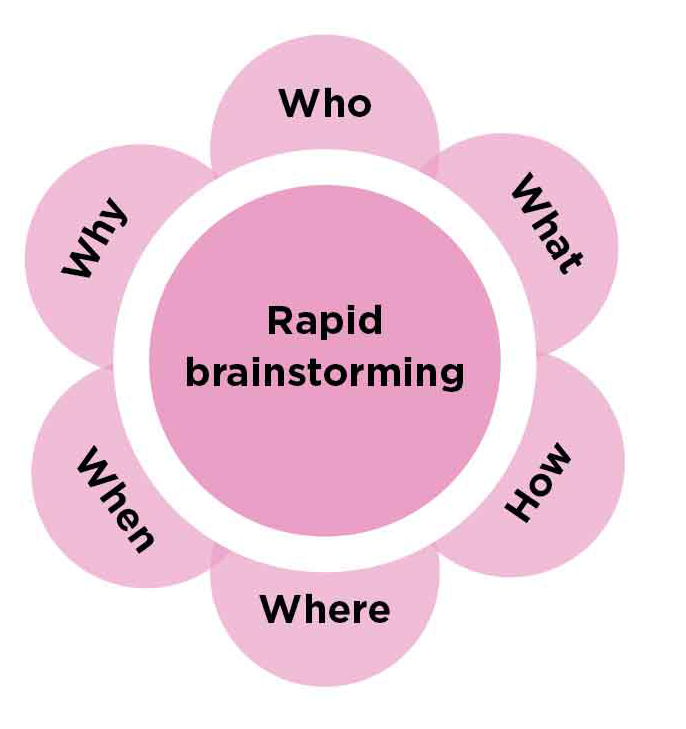By Declan Noone
Have you ever had a great idea while showering? That ‘aha’ moment, for me is priceless because this ‘aha’ usually comes after a period of frustration. Frustration because I haven’t been able to find that great idea or solution to the challenge I or my team face.
What happens prior to that ‘aha’ moment? A couple of quick ideas passes through the mind, followed by an almost immediate assessment, and one idea sticks out. That ‘one’ idea grabs you, you become emotionally invested in it and you start putting this idea into practise. Within a team you start promoting your own idea, sometimes fighting for it to be realised.
BUT, was this the right idea to begin with?
Unstructured brainstorming in many cases leads to only a handful of ideas in the beginning, with ‘brainstormers’ being highly emotionally invested in their own ideas as they start to put them into practise. This unstructured method narrows you down in the beginning and prevents teams from exploring other options. Furthermore, the nature of unstructured idea generation is such, that you tend to bring your own baggage of mental models and biases, thereby narrowing your focus.
In order to overcome this predicament, when we develop leaders, we teach a structured brainstorming methodology that allows for more ideas to be explored within a psychologically safe space by:
(1) rapidly brainstorm ideas,
(2) exploring opportunities, hurdles and resource requirements, and
(3) action planning.
We call this framework ‘Tic Tac Talk’

Tic Tac Talk is a fusion of rapid brainstorming with the ‘Who, What, Why, Where, When and How’ used in the military decision-making process to construct your mission statement. The mechanism it utilises is designed to mitigate the impact of your Mental Models and Biases while negotiating the paradox of providing both structure and freedom of creativity/exploration.
How to use Tic Tac Talk?
Step 1: Rapid Brainstorming
Identify your problem/challenge. Get the team together. Set your brainstorming question. Generate as many ideas as you can in 1 minute. Use one post-it per idea. After 1 minute, individuals share their ideas and places them in the middle of the table, like you are playing ‘Snap’. Cluster similar ideas. Repeat several times.
Outcome: You force all present to identify solutions beyond the obvious ones. Asking participants to the same question several times pushes them to move beyond their fixed ideas i.e. their Mental Models. You move away from thought processes that revolve around ‘this is the way we always address these challenges’, or ‘we can’t do that’.
Step 2: Discuss and Decide
Place all of the suggested solutions from Step 1 on a wall. Discuss and Decide within the team each idea sharing opinions and perspectives. Then narrow your selection to a few and vote on the preferred course of action.
Outcome: Increased engagement levels and active participation as each individual is afforded an opportunity to air their opinion and bring their experience and perspectives to bear on finding the solution. Feeling heard and valued improves team cohesion and alignment behind the selected solution.
Step 3: Explore
Without limitations have the team identify, for each point in the Framework (Who, What, Where, When, Why, and How’) as many questions as possible radiating out from the central point. Don’t try to answer any of the questions as you go along.Concentrate on thinking up as many questions as you can.
Outcome: You collectively mind map pitfalls, additional stakeholder that must be engaged, required resources, etc. The collective drive and insights help identify early the relationships, resources, and hurdles that will be met in making this solution a reality.
Step 4: Action Planning
Finally, answer each of the questions. Then generate an action plan to include: Requirements; Responsibilities; Resources Required; Timelines and ; Means of communication and co-ordination.
Outcome: An aligned team with a clarity of purpose and understanding of what is required. The team is emotionally involved and engaged in bringing the solution to its conclusion.
Overall, using the Tic Tac Talk framework, provides a simple and structured mechanism whereby teams can collectively engage in a psychologically safe space to identify solutions to the challenges they face and decide on a path forward.
Give it a try!!!

